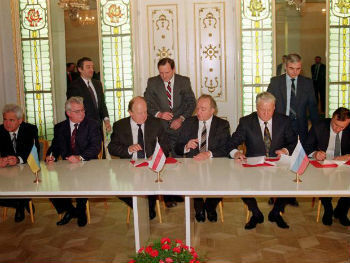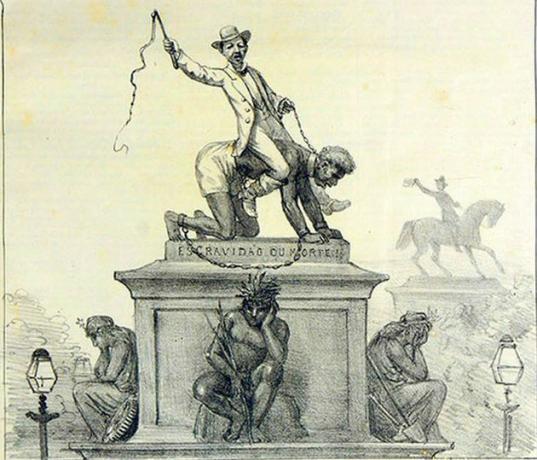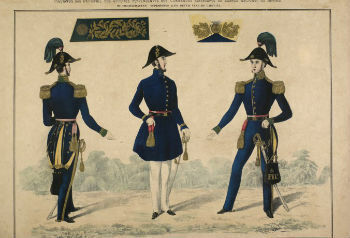THE Union of Soviet Socialist Republics (USSR) ended on November 8, 1991.
Unable to keep up with Western technological advances and maintain a level of quality for the population, the USSR slowly declined.
Likewise, the republics that formed the Soviet Union demanded more self-determination and political freedoms.
Main causes
There are several reasons why USSR collapse:
- Crisis triggered by the economic model that forced the population to live with the scarcity of many consumer goods;
- Poorly conducted reforms that led to the deterioration of the population's quality of life;
- Popular discontent with the offer of products, especially food;
- Differences in the quality of life between citizens of the USSR and those of the capitalist bloc;
- Concentration of power;
- Weakening of central power;
- Authoritarianism, with press censorship and the most diverse forms of popular demonstrations;
- Control of the Church and other religions;
- Weakening of Communist Party discipline due to ideological division;
- Cold War and pressure from the West.
Summary
In 1985, Mikhail Gorbachev assumed the secretary of the Communist Party and put into practice the plans of the perestroika (restructuring) and glasnost (transparency).
This policy intended:
- modernize Russia's economy;
- reduce the State's participation in the economy;
- decrease government interference in civil affairs.
The model quickly showed signs of inefficiency. The Soviet Union had to reduce military spending, interfere less in the political problems of socialist countries, and also limited economic aid to these nations.
Thus, the Soviets withdrew their troops from Afghanistan, without having achieved the victory they wanted.
Likewise, the countries of the Eastern Europe they fought for more freedoms. In 1989, the people of Berlin tore down the wall that separated the city and precipitated the reunification of Germany.
Populations from countries like Czechoslovakia, Hungary, Bulgaria, Poland and Romania also took to the streets to demand change and more democracy.
Unlike what had happened in inner years, when Soviet troops intervened, this time the soldiers stayed in barracks.
In this way, these countries were able to redemocratize and many joined the European Union.
Read more about:
- Perestroika and Glasnost
- Ronald Reagan
- Fall of the Berlin Wall
Separatist Movements

Thousands of people celebrate Lithuania's independence in 1990
The internal situation was chaotic, as separatist movements emerged in various regions of the USSR.
The crisis started in the 1980s, but deepened in the 1990s, with the rise of nationalist tendencies in virtually every Soviet republic.
The first separatist demonstration to surface was in Lithuania. Protests followed in Estonia and Latvia, followed by Georgia, Azerbaijan, Moldova and Ukraine.
In parallel, Gorbachev was questioned by the Russian bourgeoisie, fearful of losing privileges, and opponents.
The main opposition leader was Boris Yeltsin, who demanded radical reforms and planned a coup against Gorbachev.
Coup on the Communist Party

Former USSR leaders sign Commonwealth of Independent States treaty
The events of August 1991, however, marked the collapse, when a coup suspended the Communist Party's activities.
The party lost its powers in the Supreme Council of the USSR, by decision of the deputies in Congress.
The dissolution of the Congress of the Soviet Union was announced in September 1991.
On December 8, the signing of the dissolution of the Soviet Union took place between the leaders of Ukraine, Belarus and Russia.
Then, the CIS (Community of Independent States), which consisted in bringing together the former republics that formed the USSR. Of the 15 countries, 12 amended the treaty.
The Baltic republics - Estonia, Lithuania and Latvia - refused to participate, claiming that their incorporation into the USSR had taken place under coercion.
Read more about the Communism.
Russian Federation
The Russian Federation assumed the USSR's international obligations and the countries' external debts.
THE Russia withdrew USSR assets left in foreign countries, including facilities such as embassies and consulates.
The command of the military forces, the control of nuclear weapons and the management of space exploration research came under Russian administration.
The nuclear weapons belonging to Ukraine, Belarus and Kazakhstan have been destroyed because these nations have given up on this type of military equipment.
The Russian army withdrew from the Baltic countries, which had to restructure their military forces after independence.
Consequences of the End of the USSR
With the end of the USSR, the world only had the capitalism it's the liberalism as economic and political ideology.
The end of the Soviet regime inaugurated the process of globalization and the market economy that dominates the planet today.
In addition, we verified that:
- Russian territory and population were reduced by a quarter;
- Access to seaports became an obstacle;
- Countless ethnic conflicts took over that of the former Soviet republics, which also began to dispute territories;
- A single superpower came into being: the United States.
Read more about Russian flag.
Curiosities
- The liberal stance taken by Gorbachev earned him the "Nobel Peace Prize" in 1990 in a clear demonstration that the measures pleased the West.
- The event is considered the greatest geopolitical catastrophe of the 20th century.
- Once the USSR officially ceased to exist, the population began to remove and topple all symbols of socialism as statues of Lenin, Stalin, Trotsky, Marx and other party leaders.
Read more: Stalinism in the USSR.


